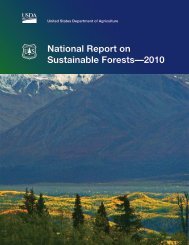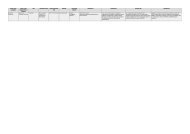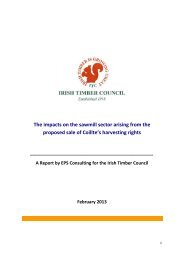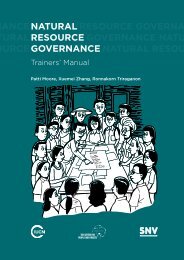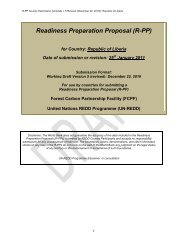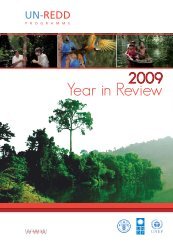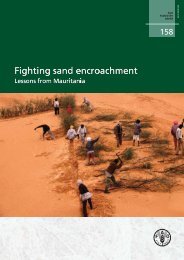pdf 1242 KByte - JIKO
pdf 1242 KByte - JIKO
pdf 1242 KByte - JIKO
You also want an ePaper? Increase the reach of your titles
YUMPU automatically turns print PDFs into web optimized ePapers that Google loves.
Policy Paper: Assessing prerequisites for market-based REDD+ activities 8<br />
At the national level, however, developing countries willing to participate in a future market-based REDD+<br />
mechanism will need to establish robust reference levels that ensure additionality of emission reductions and<br />
minimise leakage. The process of setting reference levels includes several steps and requires data and analysis<br />
to determine the historic emissions and removals which may lie outside the current capacity of many developing<br />
countries (Meridian Institute 2011a). We will first present the current status of the negotiations at<br />
UNFCCC level and their requirements for the establishing of reference levels before discussing further prerequisites<br />
REDD+ countries should meet and what these requirements mean for the country’s capacities.<br />
Requirements at UNFCCC level<br />
At the UN-level, the debate on REDD+ has for a long time centred around the question whether reference<br />
levels should be set at national or subnational scale. Since subnational reference levels are restricted to a<br />
smaller geographical area or to the boundaries of a project they do only require a limited set of data allowing<br />
for near-time and cost-effective implementation. In terms of effectiveness, however, subnational reference<br />
levels are highly problematic since they are especially vulnerable to the spatial displacement of carbon emissions<br />
(leakage). The problem of intra-national leakage can be effectively controlled for when national reference<br />
levels are established, allowing governments to pursue a broader set of policies and giving them a<br />
stronger sense of ownership (Wertz-Kanounnikoff / Angelsen 2009). These and further arguments led the<br />
UN negotiations on REDD+ to tend towards a national approach while not totally excluding the application<br />
of subnational reference levels. Hence, the Cancun Agreements request future REDD+ countries to develop<br />
national reference levels which can be combined from subnational reference levels. Subnational reference<br />
levels however will only be accepted as an interim measure (UNFCCC 2011, Decision 1/CP.16 para 71 (b)).<br />
At the Durban climate summit, these requirement were again confirmed (UNFCCC 2012, Decision 12/CP.17<br />
para 11).<br />
When setting reference levels, different reference periods can be used allowing for historical, historical<br />
adjusted or projected reference levels. The country’s historical emissions represent a useful foundation for<br />
establishing scientifically robust reference levels, as historic data is expected to be reliable in predicting what<br />
will happen in the short term future. Another advantage in terms of reproducibility is that they are based on a<br />
simple and transparent calculation. Such an approach would further allow countries to better understand the<br />
drivers of deforestation and forest degradation and their extend and location which is crucial for the development<br />
of national REDD+ strategies (Meridian Institute 2011b). However, especially for countries with<br />
high forest cover but small rates of deforestation, an adjustment of the historical reference level to specific<br />
national circumstances could further improve accuracy and predictability of future deforestation and forest<br />
degradation activities. These and other arguments have also been recognized at UNFCCC-level where COP<br />
15 established that reference levels should take into account historical data and be adjusted for national circumstances<br />
(UNFCCC 2010, Decision 4/CP15 para 7). At the 17 th Conference of the Parties in Durban, Parties<br />
repeated this decision and further emphasized the need to include details on how the national circumstances<br />
were used to adjust the reference level (UNFCCC 2012, Decision 12/ CP.17 para 9).<br />
COP16 decided to integrate the whole range of REDD+ activities in a future mechanism – possibly rewarding<br />
countries for reducing emissions from deforestation and forest degradation, conservation of forest carbon<br />
stocks, sustainable management of forests as well as enhancement of carbon stocks. Since then, countries<br />
have to set the scope of their reference level accordingly. Following the guidelines for submission of information<br />
on reference levels included in the “Guidelines for submission of information on reference levels”,<br />
“significant pools and/or activities should not be excluded” (UNFCCC 2012, Annex of Decision 12/CP.17)<br />
Nicolas Kreibich, Christof Arens and Wolfgang Sterk<br />
Wuppertal Institute




